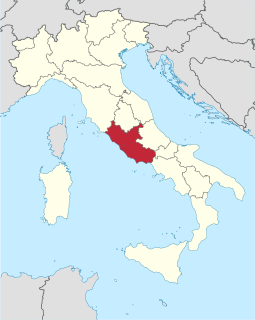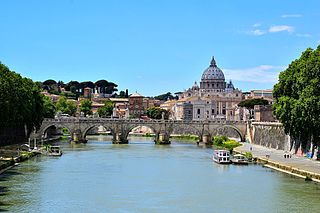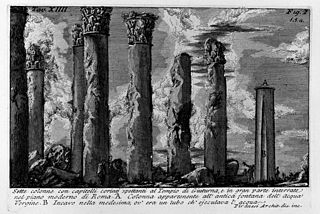Related Research Articles

Classics or classical studies is the study of classical antiquity, and in the Western world traditionally refers to the study of Classical Greek and Roman literature in their original languages of Ancient Greek and Latin, respectively. It may also include Greco-Roman philosophy, history, and archaeology as secondary subjects.

Lazio is one of the 20 administrative regions of Italy. Situated in the central peninsular section of the country, it has 5,864,321 inhabitants – making it the second most populated region of Italy – and its GDP of more than €197 billion per year means that it has the nation's second largest regional economy. The capital of Lazio is Rome, which is also the capital and largest city of Italy.

Pecorino Romano is a hard, salty Italian cheese, often used for grating, made with sheep's milk. The name "pecorino" simply means "ovine" or "of sheep" in Italian; the name of the cheese, although protected, is a simple description rather than a brand: "[formaggio] pecorino romano" is simply "sheep's [cheese] of Rome".

The Tiber is the third-longest river in Italy and the longest river in Central Italy, rising in the Apennine Mountains in Emilia-Romagna and flowing 406 kilometres (252 mi) through Tuscany, Umbria and Lazio, where it is joined by the river Aniene, to the Tyrrhenian Sea, between Ostia and Fiumicino. It drains a basin estimated at 17,375 square kilometres (6,709 sq mi). The river has achieved lasting fame as the main watercourse of the city of Rome, founded on its eastern banks.

The tale of the founding of Rome is recounted in traditional stories handed down by the ancient Romans themselves as the earliest history of their city in terms of legend and myth. The most familiar of these myths, and perhaps the most famous of all Roman myths, is the story of Romulus and Remus, twins who were suckled by a she-wolf as infants in the 8th century BC. Another account, set earlier in time, claims that the Roman people are descended from Trojan War hero Aeneas, who escaped to Italy after the war, and whose son, Iulus, was the ancestor of the family of Julius Caesar. The archaeological evidence of human occupation of the area of modern-day Rome, Italy dates from about 14,000 years ago.

Aius Locutius or Aius Loquens, was a Roman deity or numen associated with the Gallic invasions of Rome during the early 4th century BC.

The Campus Martius was a publicly owned area of ancient Rome about 2 square kilometres in extent. In the Middle Ages, it was the most populous area of Rome. The IV rione of Rome, Campo Marzio, which covers a smaller section of the original area, bears the same name.

Venatio was a type of entertainment in Roman amphitheaters involving the hunting and killing of wild animals.

The Saepta Julia was a building in the Campus Martius of Rome, where citizens gathered to cast votes. The building was conceived by Julius Caesar and dedicated by Marcus Vipsanius Agrippa in 26 BCE. The building replaced an older structure, called the Ovile, built as a place for the comitia tributa to gather to cast votes. The Saepta Julia can be seen on the Forma Urbis Romae, a map of the city of Rome as it existed in the early 3rd century CE. Part of the original wall of the Saepta Julia can still be seen right next to the Pantheon.

Ceva, the ancient Ceba, is a small Italian town in the province of Cuneo, region of Piedmont, 49 kilometres (30 mi) east of Cuneo. It lies on the right bank of the Tanaro on a wedge of land between that river and the Cevetta stream.

In Ancient Rome, the Capitoline Games were annual games (ludi). They started out as religious holiday celebrations that "called upon divine support to ensure continued prosperity for the state." They were instituted by Camillus, 387 BC, in honor of Jupiter Capitolinus, and in commemoration of the Capitol's not being taken by the Gauls that same year. The games lasted sixteen days, starting on October 15.

Latium is the region of central western Italy in which the city of Rome was founded and grew to be the capital city of the Roman Empire.
The diribitorium was a public voting hall situated on the campus Martius in Ancient Rome. In this building, the votes cast by the people were counted by diribitores. Construction of the building was started by Marcus Agrippa but finished by Augustus in 7 BC.
The Porticus Argonautarum was an ancient structure in Rome.

Plăcintă is a Romanian, Moldovan and Ukrainian traditional pastry resembling a thin, small round or square-shaped cake, usually filled with apples or a soft cheese such as Urdă.
The Feriae Latinae or Latin Festival was an ancient Roman religious festival held in April on the Alban Mount. The date varied, and was determined and announced by the consuls each year when they took office. It was one of the most ancient festivals celebrated by the Roman state and is supposed to have predated the founding of Rome—in historical terms, to have dated to a pre-urban pastoral age. It continued to be held into the 3rd century AD, and perhaps later.

The Amburbium was an ancient Roman festival for purifying the city; that is, a lustration (lustratio urbis). It took the form of a procession, perhaps along the old Servian Wall, though the length of 10 kilometers would seem impractical to circumambulate. If it was a distinct festival held annually, the most likely month is February, but no date is recorded and the ritual may have been performed as a "crisis rite" when needed.

The Temple of Isis and Serapis was a double temple in Rome dedicated to the Egyptian deities Isis and Serapis on the Campus Martius, directly to the east of the Saepta Julia. The temple to Isis, the Iseum Campense, stood across a plaza from the Serapeum dedicated to Serapis. The remains of the Temple of Serapis now lie under the church of Santo Stefano del Cacco, and the Temple of Isis lay north of it, just east of Santa Maria sopra Minerva. Both temples were made up of a combination of Egyptian and Hellenistic architectural styles. Much of the artwork decorating the temples used motifs evoking Egypt, and they contained several genuinely Egyptian objects, such as couples of obelisks in red or pink granite from Syene.

The Temple of Matidia was a Roman temple on the Campus Martius in ancient Rome dedicated to Salonia Matidia, who was deified after her death in 119 by her son-in-law Hadrian. He began construction immediately after her deification, choosing a site near the Pantheon and the Saepta Julia, both of which he restored or rebuilt. A lead water pipe inscribed 'templo matidiae' was found near Sant'Ignazio, which may indicate the temple's location. After Hadrian died and was deified, his own temple was built next to that of Matidia.

The Basilica of Neptune was a basilica built in Rome by Marcus Vipsanius Agrippa in honour of Neptune and in celebration of his naval victories at Mylae, Naulochus and Actium. Near the site of the Pantheon, its remains were restored under Hadrian for an unknown use. The Temple of Hadrian was once misidentified with the basilica.
References
| | This Ancient Rome–related article is a stub. You can help Wikipedia by expanding it. |